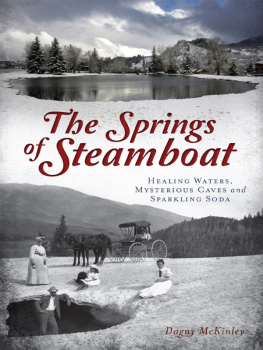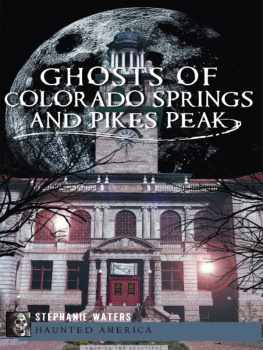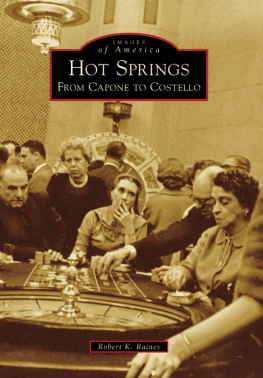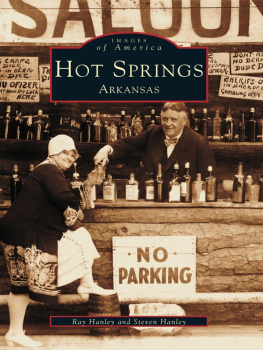

Published by The History Press
Charleston, SC 29403
www.historypress.net
Copyright 2013 by Dagny McKinley
All rights reserved
First published 2013
e-book edition 2013
Manufactured in the United States
ISBN 978.1.61423.888.1
Library of Congress CIP data applied for.
print edition ISBN 978.1.60949.880.1
Notice: The information in this book is true and complete to the best of our knowledge. It is offered without guarantee on the part of the author or The History Press. The author and The History Press disclaim all liability in connection with the use of this book.
All rights reserved. No part of this book may be reproduced or transmitted in any form whatsoever without prior written permission from the publisher except in the case of brief quotations embodied in critical articles and reviews.
This book is dedicated to the mineral springs of Steamboat Springsfor what they have taught me about the history of this town and for their patience with the decisions of mankind.
CONTENTS
ACKNOWLEDGEMENTS
Thank you to Edith Hornik Beer, without whose encouragement I would never have acknowledged myself as a writer. A huge thank-you to the Steamboat community for their help and story contributions. Thanks to Bill Fetcher for providing historic photographs of the Strawberry Park Hot Springs. To George Tolles for his personal notes, time and help. To Jim Crawford for helping me make the manuscript as accurate as possible with the knowledge he had, for his time and his willingness to review my manuscript. To the Tread of Pioneers Museum for all its help and patience as I researched this project. To Joe Stepan at the Strawberry Park Hot Springs for providing so much information. To Pat Carney and Jeanne Gillaspie for their contribution of historic photographs and information on the Old Town Hot Springs and Steamboat Spring Health and Recreation Association. To the Steamboat Pilot for the mass amount of information, without which this book would not have been possible. To Tom Wither for sharing personal family stories and photographs. To Corey Kopishke for the beautiful summer scenic shot of the Old Town Hot Springs. To Jody Condie for sending a copy of the postcard of Steamboat. To Suzie Hawkins, Rodney Pryde, Cookie Lockhart, Chris Erickson and Rick and Linda Banter for their story contributions. To Emily Katzman, without whose help this book would never have been finished in time. To Kim Keith for her contribution of photography and friendship. And to my family and my dog for their patience as I worried my way through every word of this project.
INTRODUCTION
The town of Steamboat Springs was named for a once-famous spring that sounded like the chugging of a steamboat. Steamboat was built close to the mineral springs for all the wonders they offered, from drinking water to bathing opportunities to medical remedies. Today, when people hear the name Steamboat Springs, they think of a world-class ski resort. They think of hiking, biking, fly-fishing and access to endless outdoor recreational opportunities. Very few people today come to visit Steamboat for the healing powers of the mineral springs. Many may spend an afternoon or evening at the Old Town Hot Springs or the Strawberry Park Hot Springs, soaking in the waters without realizing the history of the springs. These two springs have been developed as focal points for recreational activities while the remainder of the springs sit, unassuming, at the edge of town where they often go unnoticed.
Just a little while ago, a visitor to Steamboat asked me how the town got its name. Most people who live here know the story of the Steamboat Spring, but until I began this book, I had never visited that spring or the sulphur spring that offers a very distinctive greeting to those driving into town. I had no idea that the springs here had so much to offer. As the town grew up, people like me, without any emotional ties to the springs, made development decisions they thought best for the direction of the town. In the process, some springs disappeared.
I have lived in the Yampa Valley for over ten years. Ten years before that, I was an occasional visitor to the area. I know all the runs on the ski mountain. I have both hiked and skied them. I know what the snow conditions are like daily but didnt know that Steamboat was once a destination town for healing, with people traveling across the country solely to visit the 150 mineral springs found here. The first encounter with the valley was often a soak in the Old Town Hot Springs, or Bath Spring, as it was once known. Visitors came to drink from the Lithia Spring as a cure for all sorts of physical ailments. As the town developed, ranchers moved in and became the primary industry in town. Carl Howelsen introduced skiing for recreation and ski jumping in 1914 when he built Steamboats first ski jump. With that, he changed the course of this towns history. The focus for tourism became skiing. Every winter, people flock from around the world to try Steamboats famous champagne powder.

Postcard showing Steamboat and Old Town Hot Springs. Courtesy Jody Condie.
Recently, traditional weather patterns have been changing. The seasons appear to be shifting, with snow falling later in the season. Weather cycles of drought or extreme moisture are not uncommon. In dry years, the tourism industry suffers, not to mention the ranchers and townspeople. So Steamboat is yet again adapting by building a reputation as a biking destination in the summer.
With each new fad, older ones fade into the background. The activities that draw in the biggest crowds tend to get the most dollars in regard to expansion, preservation and attention. There have been periods in Steamboats history when some of the mineral springs were allowed to fall into disrepair. Fortunately, there have always been some strong voices in the community that have fought for the preservation and protection of our springs. One of those voices was that of Lulita Crawford Pritchett, granddaughter of the founding mother and father of the town, James and Margaret Crawford. Another crucial person who has given a voice to the springs is George Tolles, who drinks daily from the Lithia Spring and soaks regularly in the Old Town Hot Springs. Dorothy Wither was a proponent of the Lithia water and the Old Town Hot Springs until her passing.
Without the mineral springs, Steamboat would never have become the town it is today. To visit the various springs now is at once to see the history of this town and the future. In the 1950s, children, including Tom Wither, set up a volunteer-guided tour of the various springs. Their headquarters were at the Soda Spring. They had a big sign that read Free tours of the hot springs. The boys researched about five of them and read the information to customers. It wasnt a big thing, remembers Tom, but every now and then tourists would call or come by and give us a tip of a dollar or something. Currently, the Tread of Pioneers Museum downtown offers a free walking tour of the mineral springs (excluding Strawberry Park Hot Springs) once a week during the summer months.
My hope is that this book will stand as another voice for each of these springs. These words hopefully tell an accurate history of these waters while leaving open the possibility that we may still not know the extent of the beneficial attributes of these springs, how they serve the environment and how they can healmentally, physically and spirituallythose of us fortunate enough to call Steamboat home.
Next page










